Development of SmartStore E-Commerce Site in Java EE: Project
VerifiedAdded on 2019/10/31
|6
|1096
|302
Project
AI Summary
This project report details the development of a SmartStore e-commerce site using Java EE. It begins with an architectural overview, outlining the Model-View-Controller (MVC) design pattern and the roles of the view, model, and controller. The report then describes the typical workflow for creating customer orders, starting from the home page and navigating through product categories, the shopping cart, and the checkout process. An end-user manual is provided, explaining the three-tier architecture, where Java Server Pages (JSP) and Servlets handle the presentation layer, and Enterprise Java Beans (EJB) manage the business logic. Finally, the report includes detailed test instructions, covering the installation of XAMPP (with MySQL) and Maven, compiling the project, deploying it to a Glassfish server, and testing the application within a Netbeans development environment. The instructions also address potential issues during the initial build and deployment phases.
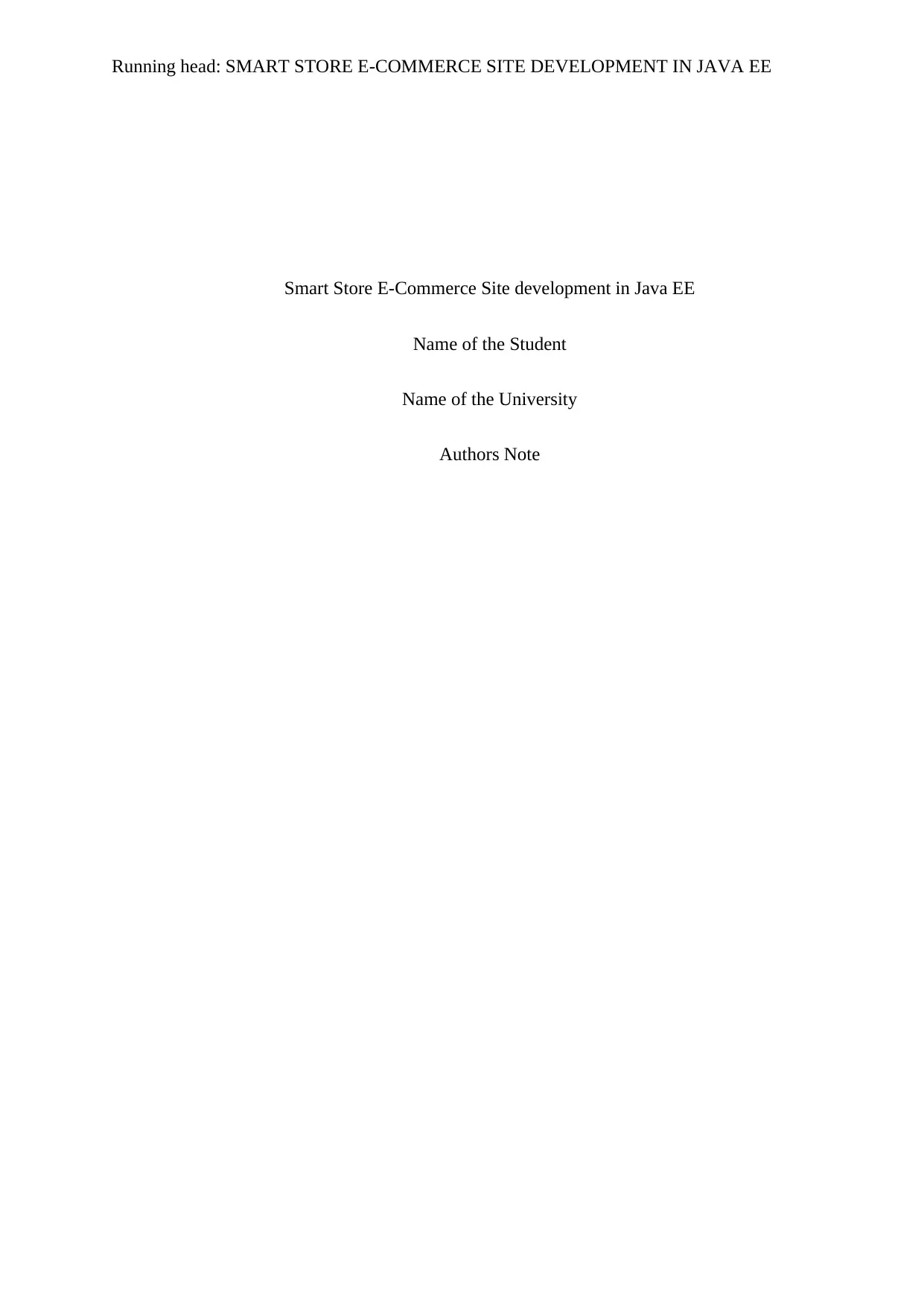
Running head: SMART STORE E-COMMERCE SITE DEVELOPMENT IN JAVA EE
Smart Store E-Commerce Site development in Java EE
Name of the Student
Name of the University
Authors Note
Smart Store E-Commerce Site development in Java EE
Name of the Student
Name of the University
Authors Note
Paraphrase This Document
Need a fresh take? Get an instant paraphrase of this document with our AI Paraphraser
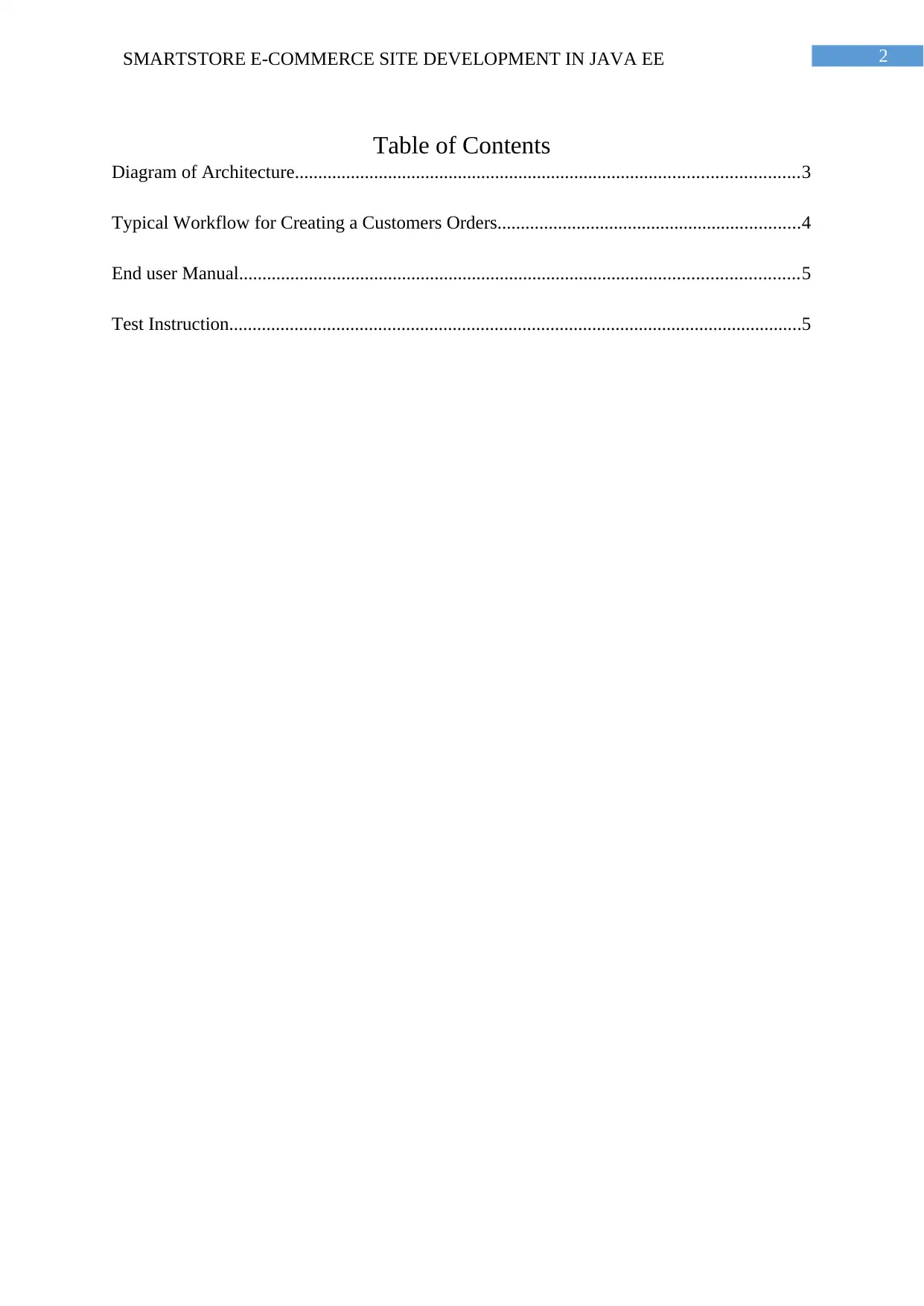
2SMARTSTORE E-COMMERCE SITE DEVELOPMENT IN JAVA EE
Table of Contents
Diagram of Architecture............................................................................................................3
Typical Workflow for Creating a Customers Orders.................................................................4
End user Manual........................................................................................................................5
Test Instruction...........................................................................................................................5
Table of Contents
Diagram of Architecture............................................................................................................3
Typical Workflow for Creating a Customers Orders.................................................................4
End user Manual........................................................................................................................5
Test Instruction...........................................................................................................................5
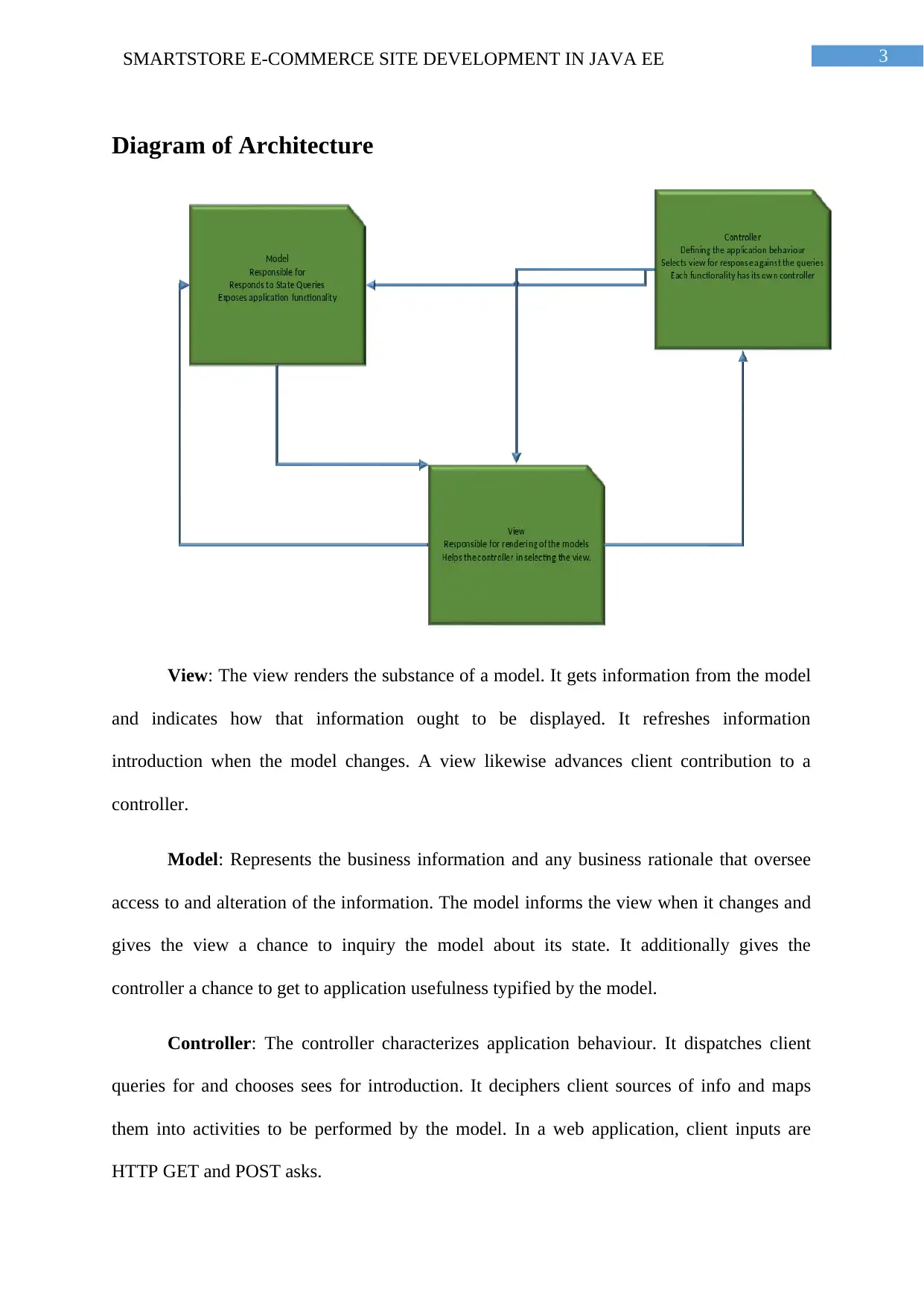
3SMARTSTORE E-COMMERCE SITE DEVELOPMENT IN JAVA EE
Diagram of Architecture
View: The view renders the substance of a model. It gets information from the model
and indicates how that information ought to be displayed. It refreshes information
introduction when the model changes. A view likewise advances client contribution to a
controller.
Model: Represents the business information and any business rationale that oversee
access to and alteration of the information. The model informs the view when it changes and
gives the view a chance to inquiry the model about its state. It additionally gives the
controller a chance to get to application usefulness typified by the model.
Controller: The controller characterizes application behaviour. It dispatches client
queries for and chooses sees for introduction. It deciphers client sources of info and maps
them into activities to be performed by the model. In a web application, client inputs are
HTTP GET and POST asks.
Diagram of Architecture
View: The view renders the substance of a model. It gets information from the model
and indicates how that information ought to be displayed. It refreshes information
introduction when the model changes. A view likewise advances client contribution to a
controller.
Model: Represents the business information and any business rationale that oversee
access to and alteration of the information. The model informs the view when it changes and
gives the view a chance to inquiry the model about its state. It additionally gives the
controller a chance to get to application usefulness typified by the model.
Controller: The controller characterizes application behaviour. It dispatches client
queries for and chooses sees for introduction. It deciphers client sources of info and maps
them into activities to be performed by the model. In a web application, client inputs are
HTTP GET and POST asks.
⊘ This is a preview!⊘
Do you want full access?
Subscribe today to unlock all pages.

Trusted by 1+ million students worldwide
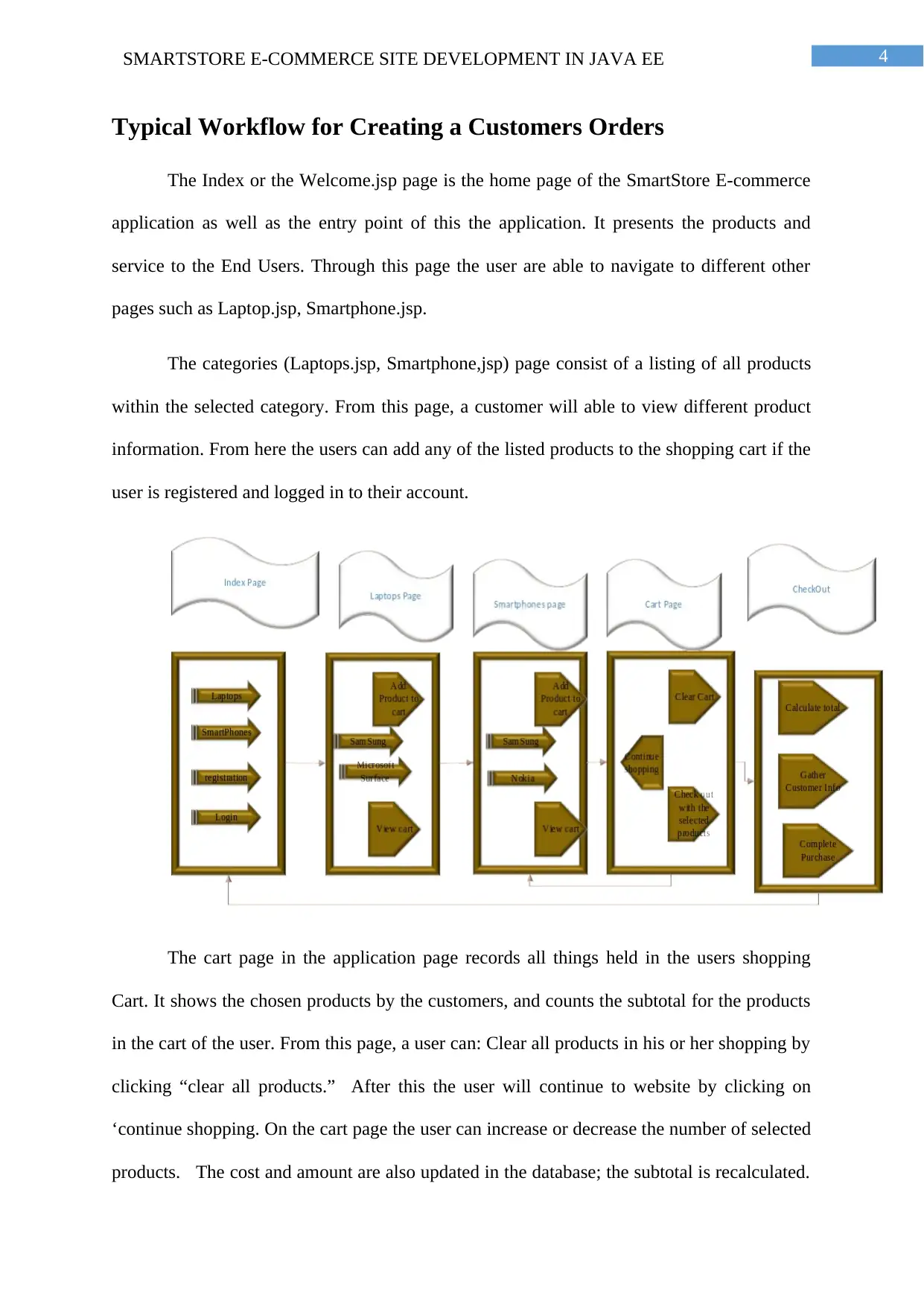
4SMARTSTORE E-COMMERCE SITE DEVELOPMENT IN JAVA EE
Typical Workflow for Creating a Customers Orders
The Index or the Welcome.jsp page is the home page of the SmartStore E-commerce
application as well as the entry point of this the application. It presents the products and
service to the End Users. Through this page the user are able to navigate to different other
pages such as Laptop.jsp, Smartphone.jsp.
The categories (Laptops.jsp, Smartphone,jsp) page consist of a listing of all products
within the selected category. From this page, a customer will able to view different product
information. From here the users can add any of the listed products to the shopping cart if the
user is registered and logged in to their account.
The cart page in the application page records all things held in the users shopping
Cart. It shows the chosen products by the customers, and counts the subtotal for the products
in the cart of the user. From this page, a user can: Clear all products in his or her shopping by
clicking “clear all products.” After this the user will continue to website by clicking on
‘continue shopping. On the cart page the user can increase or decrease the number of selected
products. The cost and amount are also updated in the database; the subtotal is recalculated.
Typical Workflow for Creating a Customers Orders
The Index or the Welcome.jsp page is the home page of the SmartStore E-commerce
application as well as the entry point of this the application. It presents the products and
service to the End Users. Through this page the user are able to navigate to different other
pages such as Laptop.jsp, Smartphone.jsp.
The categories (Laptops.jsp, Smartphone,jsp) page consist of a listing of all products
within the selected category. From this page, a customer will able to view different product
information. From here the users can add any of the listed products to the shopping cart if the
user is registered and logged in to their account.
The cart page in the application page records all things held in the users shopping
Cart. It shows the chosen products by the customers, and counts the subtotal for the products
in the cart of the user. From this page, a user can: Clear all products in his or her shopping by
clicking “clear all products.” After this the user will continue to website by clicking on
‘continue shopping. On the cart page the user can increase or decrease the number of selected
products. The cost and amount are also updated in the database; the subtotal is recalculated.
Paraphrase This Document
Need a fresh take? Get an instant paraphrase of this document with our AI Paraphraser
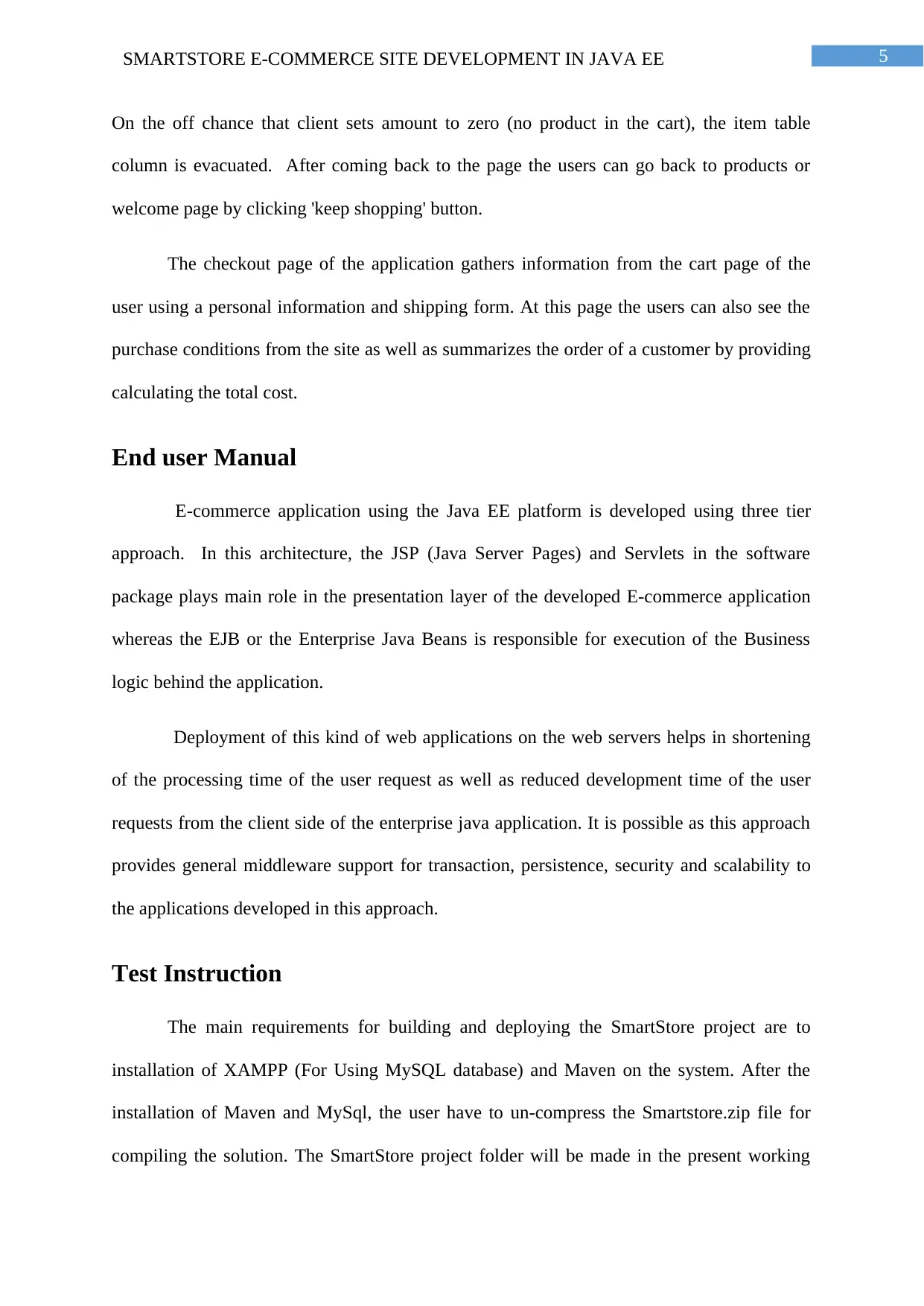
5SMARTSTORE E-COMMERCE SITE DEVELOPMENT IN JAVA EE
On the off chance that client sets amount to zero (no product in the cart), the item table
column is evacuated. After coming back to the page the users can go back to products or
welcome page by clicking 'keep shopping' button.
The checkout page of the application gathers information from the cart page of the
user using a personal information and shipping form. At this page the users can also see the
purchase conditions from the site as well as summarizes the order of a customer by providing
calculating the total cost.
End user Manual
E-commerce application using the Java EE platform is developed using three tier
approach. In this architecture, the JSP (Java Server Pages) and Servlets in the software
package plays main role in the presentation layer of the developed E-commerce application
whereas the EJB or the Enterprise Java Beans is responsible for execution of the Business
logic behind the application.
Deployment of this kind of web applications on the web servers helps in shortening
of the processing time of the user request as well as reduced development time of the user
requests from the client side of the enterprise java application. It is possible as this approach
provides general middleware support for transaction, persistence, security and scalability to
the applications developed in this approach.
Test Instruction
The main requirements for building and deploying the SmartStore project are to
installation of XAMPP (For Using MySQL database) and Maven on the system. After the
installation of Maven and MySql, the user have to un-compress the Smartstore.zip file for
compiling the solution. The SmartStore project folder will be made in the present working
On the off chance that client sets amount to zero (no product in the cart), the item table
column is evacuated. After coming back to the page the users can go back to products or
welcome page by clicking 'keep shopping' button.
The checkout page of the application gathers information from the cart page of the
user using a personal information and shipping form. At this page the users can also see the
purchase conditions from the site as well as summarizes the order of a customer by providing
calculating the total cost.
End user Manual
E-commerce application using the Java EE platform is developed using three tier
approach. In this architecture, the JSP (Java Server Pages) and Servlets in the software
package plays main role in the presentation layer of the developed E-commerce application
whereas the EJB or the Enterprise Java Beans is responsible for execution of the Business
logic behind the application.
Deployment of this kind of web applications on the web servers helps in shortening
of the processing time of the user request as well as reduced development time of the user
requests from the client side of the enterprise java application. It is possible as this approach
provides general middleware support for transaction, persistence, security and scalability to
the applications developed in this approach.
Test Instruction
The main requirements for building and deploying the SmartStore project are to
installation of XAMPP (For Using MySQL database) and Maven on the system. After the
installation of Maven and MySql, the user have to un-compress the Smartstore.zip file for
compiling the solution. The SmartStore project folder will be made in the present working
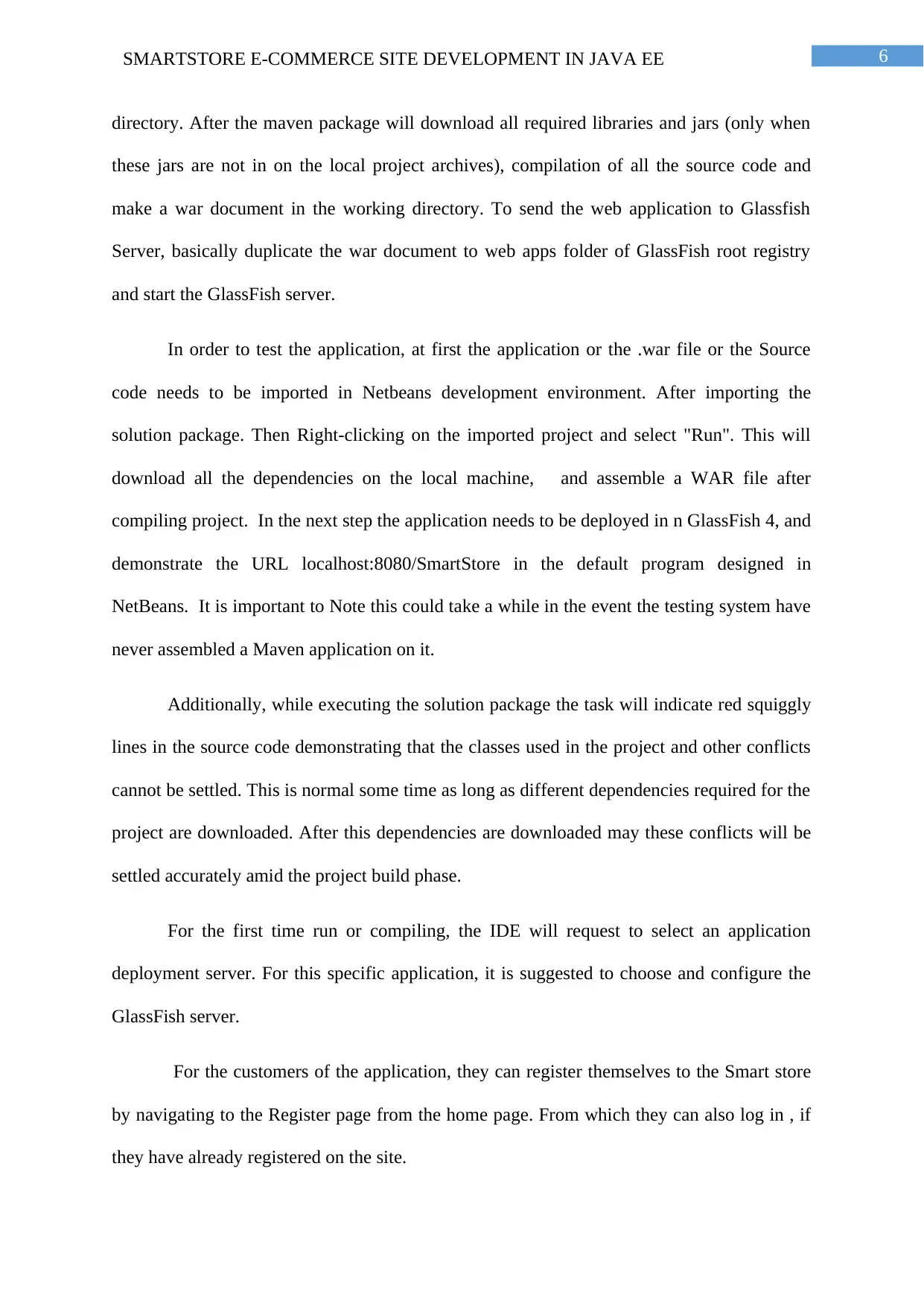
6SMARTSTORE E-COMMERCE SITE DEVELOPMENT IN JAVA EE
directory. After the maven package will download all required libraries and jars (only when
these jars are not in on the local project archives), compilation of all the source code and
make a war document in the working directory. To send the web application to Glassfish
Server, basically duplicate the war document to web apps folder of GlassFish root registry
and start the GlassFish server.
In order to test the application, at first the application or the .war file or the Source
code needs to be imported in Netbeans development environment. After importing the
solution package. Then Right-clicking on the imported project and select "Run". This will
download all the dependencies on the local machine, and assemble a WAR file after
compiling project. In the next step the application needs to be deployed in n GlassFish 4, and
demonstrate the URL localhost:8080/SmartStore in the default program designed in
NetBeans. It is important to Note this could take a while in the event the testing system have
never assembled a Maven application on it.
Additionally, while executing the solution package the task will indicate red squiggly
lines in the source code demonstrating that the classes used in the project and other conflicts
cannot be settled. This is normal some time as long as different dependencies required for the
project are downloaded. After this dependencies are downloaded may these conflicts will be
settled accurately amid the project build phase.
For the first time run or compiling, the IDE will request to select an application
deployment server. For this specific application, it is suggested to choose and configure the
GlassFish server.
For the customers of the application, they can register themselves to the Smart store
by navigating to the Register page from the home page. From which they can also log in , if
they have already registered on the site.
directory. After the maven package will download all required libraries and jars (only when
these jars are not in on the local project archives), compilation of all the source code and
make a war document in the working directory. To send the web application to Glassfish
Server, basically duplicate the war document to web apps folder of GlassFish root registry
and start the GlassFish server.
In order to test the application, at first the application or the .war file or the Source
code needs to be imported in Netbeans development environment. After importing the
solution package. Then Right-clicking on the imported project and select "Run". This will
download all the dependencies on the local machine, and assemble a WAR file after
compiling project. In the next step the application needs to be deployed in n GlassFish 4, and
demonstrate the URL localhost:8080/SmartStore in the default program designed in
NetBeans. It is important to Note this could take a while in the event the testing system have
never assembled a Maven application on it.
Additionally, while executing the solution package the task will indicate red squiggly
lines in the source code demonstrating that the classes used in the project and other conflicts
cannot be settled. This is normal some time as long as different dependencies required for the
project are downloaded. After this dependencies are downloaded may these conflicts will be
settled accurately amid the project build phase.
For the first time run or compiling, the IDE will request to select an application
deployment server. For this specific application, it is suggested to choose and configure the
GlassFish server.
For the customers of the application, they can register themselves to the Smart store
by navigating to the Register page from the home page. From which they can also log in , if
they have already registered on the site.
⊘ This is a preview!⊘
Do you want full access?
Subscribe today to unlock all pages.

Trusted by 1+ million students worldwide
1 out of 6
Related Documents
Your All-in-One AI-Powered Toolkit for Academic Success.
+13062052269
info@desklib.com
Available 24*7 on WhatsApp / Email
![[object Object]](/_next/static/media/star-bottom.7253800d.svg)
Unlock your academic potential
Copyright © 2020–2025 A2Z Services. All Rights Reserved. Developed and managed by ZUCOL.





